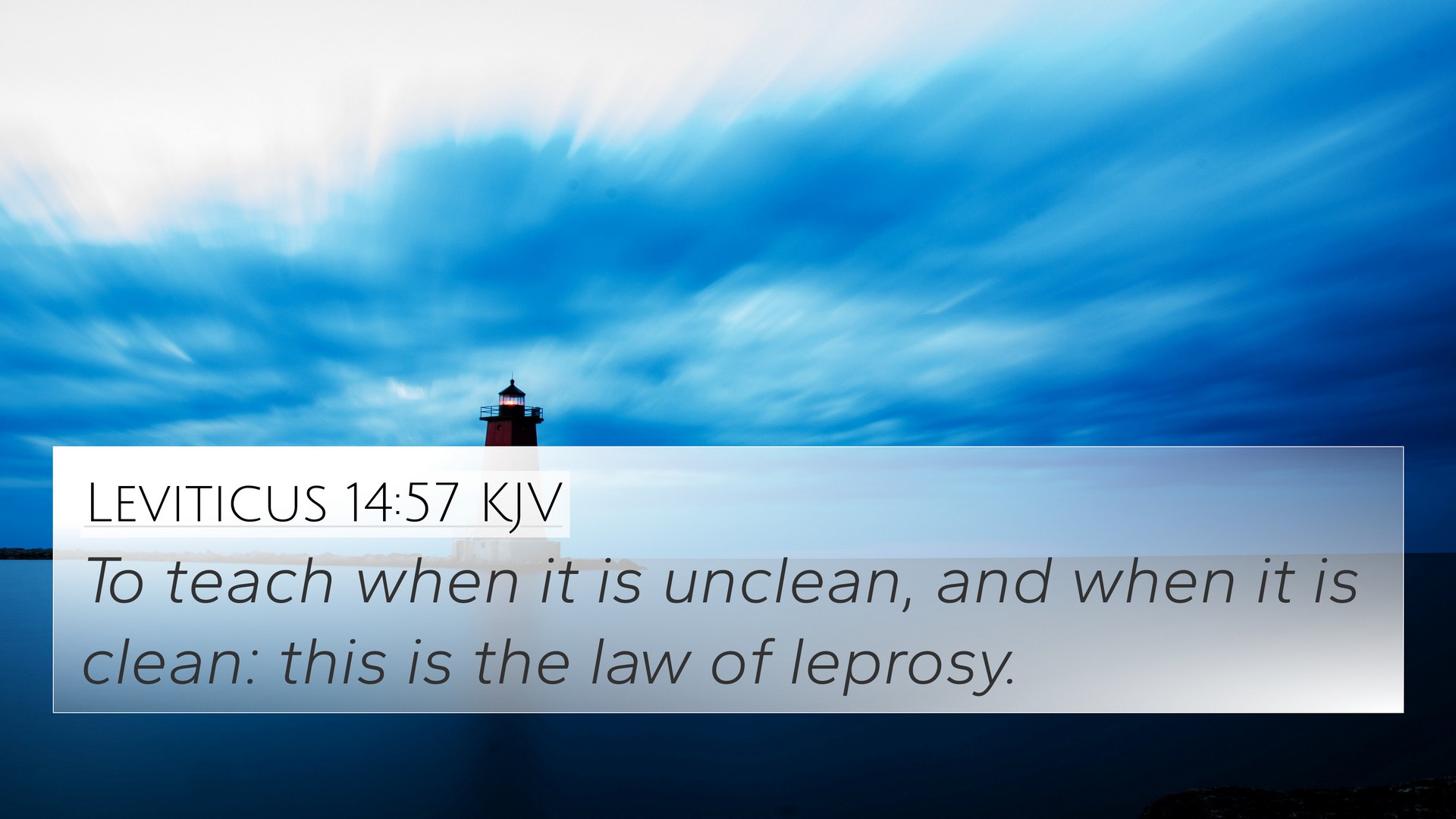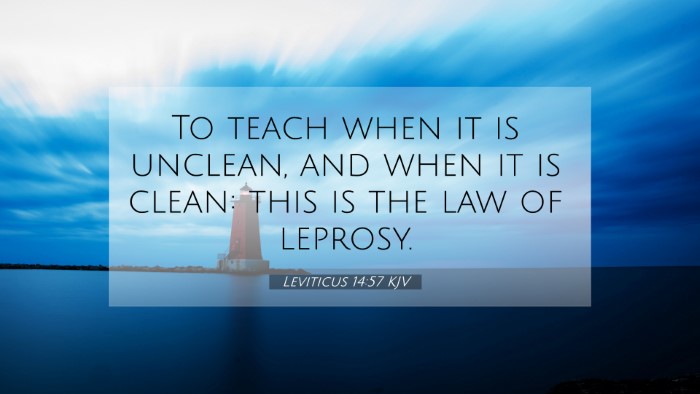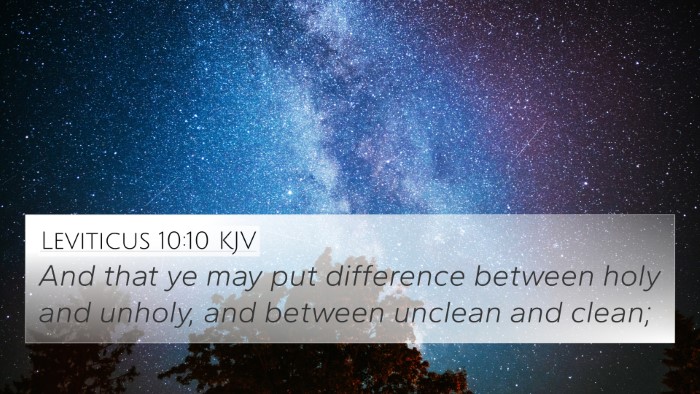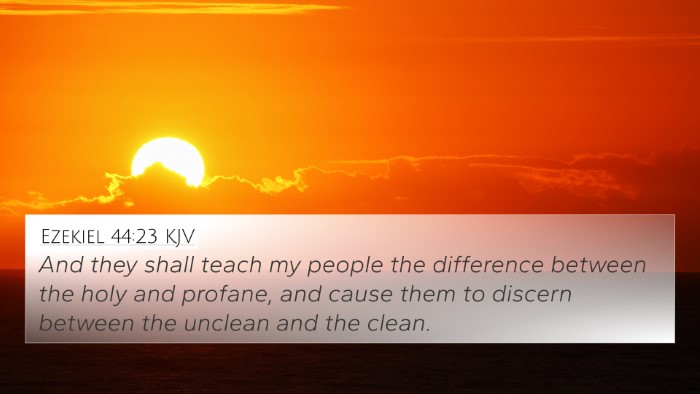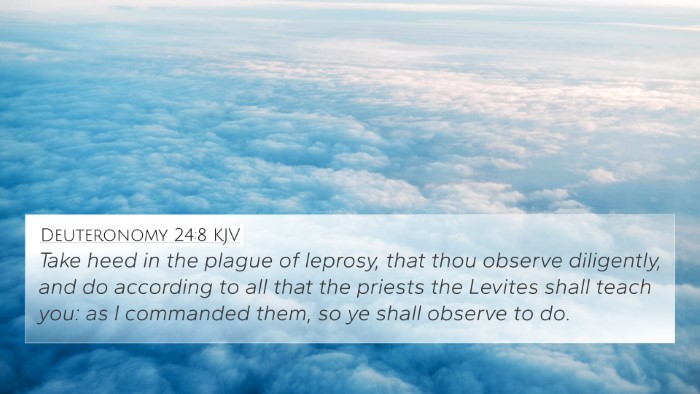Understanding Leviticus 14:57
Leviticus 14:57 states: "To teach when it is unclean and when it is clean: this is the law of leprosy." This verse concludes a section on the purification of leprosy, emphasizing the responsibilities of the priest in assessing the state of those afflicted.
In exploring the meaning and implications of this verse, we draw insights from notable public domain commentaries: Matthew Henry, Albert Barnes, and Adam Clarke. Collectively, these interpretations provide a deeper understanding of the verse within the broader context of Biblical law and the significance of purity in Israelite society.
Key Insights from Commentaries
-
Matthew Henry:
Henry emphasizes the role of the priest as a mediator between God and the people. This verse serves as a reminder of the holiness required of God's people and the ceremonial system that highlights this essential truth. The distinction between clean and unclean is pivotal in understanding sin and purity, leading believers towards spiritual reflection.
-
Albert Barnes:
Barnes explains that the law of leprosy was not just a medical guideline but a spiritual symbol, representing sin's corruptive nature. The instructions in this verse highlight the necessity of discernment and moral responsibility. The phrase "law of leprosy" indicates that understanding and teaching these statutes was crucial for communal purity and identity.
-
Adam Clarke:
Clarke notes that this verse encapsulates the entire process of discernment regarding leprous diseases—a metaphor for sin. The clear definition of clean and unclean behaviors was critical in maintaining spiritual integrity for the Israelite community. It directs believers toward recognizing spiritual ailments in their lives and the community.
Bible Cross-References
Leviticus 14:57 relates to several other scriptures that either echo its themes or contribute to its understanding. Here are some significant cross-references:
- Leviticus 13:2-3: Discusses the signs of leprosy and how a priest should determine its presence.
- Numbers 5:2-3: Addresses the need for quarantining individuals with infectious diseases to ensure community purity.
- Matthew 8:2-4: Shows Jesus' interaction with a leper, reflecting His authority and compassion over physical and spiritual ailments.
- Mark 1:40-45: Another New Testament account of Jesus healing a leper, reinforcing the connection between ceremonial laws and Christ’s redemptive work.
- Luke 17:12-14: The story of ten lepers offers insight into faith, healing, and worship.
- Hebrews 9:13-14: Discusses the cleansing of the conscience through the sacrificial system in light of Christ’s ultimate sacrifice.
- Isaiah 53:4-5: Prophetically ties leprosy (a symbol of sin) to the suffering servant, emphasizing the redemptive aspect of healing.
Thematic Connections
The connections between Bible verses allow for a comprehensive understanding of the themes of purity, sin, and redemption:
- Purity and Holiness: The emphasis on clean and unclean illustrates the broader theme of holiness that permeates the entire Hebrew Bible.
- Restoration and Healing: Leviticus speaks to the process of restoration, which finds its ultimate fulfillment in Christ's ministry of healing.
- Moral Responsibility: The call to discernment in teaching purifies the community and affirms the seriousness of sin and its implications.
Practical Applications
Understanding Leviticus 14:57 within its context not only enlightens readers about Old Testament law but also challenges them to reflect on their spiritual lives today. Here are several practical applications:
-
Self-Examination: Just as priests examined the afflicted, believers should regularly assess their spiritual health and seek purification through Christ.
-
Community Accountability: The communal aspects of purity remind us of our responsibilities to one another in the faith.
-
Understanding Redemption: The process of recognizing and addressing spiritual ailments fosters a deeper appreciation for Christ’s redemptive work.
Conclusion
Leviticus 14:57 encapsulates essential principles regarding clean versus unclean states, calling attention to the necessity of moral clarity and spiritual vigilance. The teachings in this verse resonate throughout the scriptures, inviting believers to engage in a meaningful dialogue with the Word of God. As we explore interconnected themes through Bible verse cross-references, we gain richer insights into the character of God and His redemptive plan for humanity.
